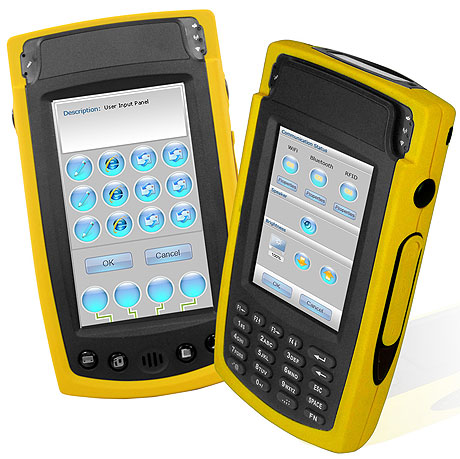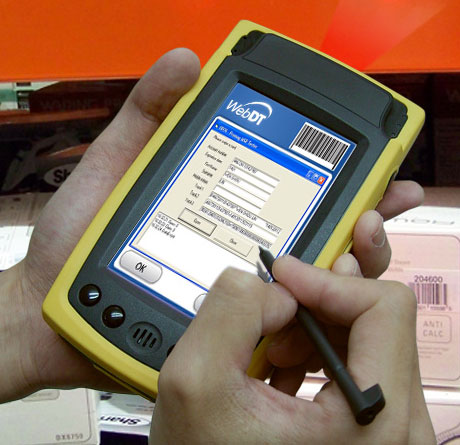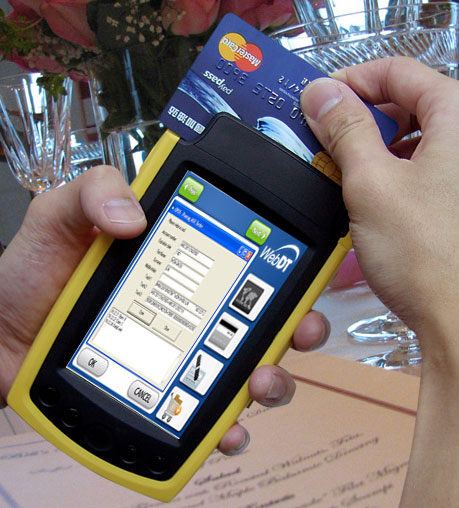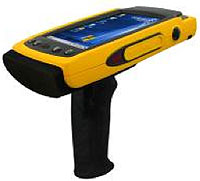|
DT Research WebDT 400 Series
Handheld Point-of-Service devices with integrated RFID, magstripe reader and scanner
By Conrad H. Blickenstorfer
DT Research, Inc., announced the WebDT 400 series, which is a new line of ruggedized handheld Point-of-Service (POS) devices designed for quick customer service applications such as mobile order-taking, ticket scanning, payment processing, as well as inventory management. The new handheld platform is available in two versions, the WebDT 435 with a physical numeric keypad and the WebDT 430 with a larger display and a virtual keyboard. Both versions have a fully-integrated magnetic card reader, 13.56MHz RFID reader and/or 1D/2D barcode scanner.
Note: On January 16, 2012, DT Research announced that the DT430 was updated to improve the overall performance with a new Samsung S3C6410 ARM 11 core processor running at 800MHz, more RAM (512MB instead of 128), and 4GB flash instead of just the original 128MB. 802.11a/b/g/n support provides faster network connection and better range coverage for a more reliable connection, as well as support for Cisco CCX 4.0 for enterprise applications. A more powerful barcode scanner has a faster scan rate, better motion tolerance, and higher optical resolution.
Rationale
Why did DT Research -- a manufacturer of tablet and panel computers as well as digital signage products -- decide to get into the handheld market which already has a number of established players?
 According to David Hale, DT Research VP of Program Management, the company saw a market opportunity for a device that improves productivity by allowing companies to do more work and provide better service within the constraints of existing, or even reduced, resources. DT Research seeks to let customers of their new handheld POS platform do more with less by carefully integrating relevant functionality into a specialized, attractive Point-of-Service device. According to David Hale, DT Research VP of Program Management, the company saw a market opportunity for a device that improves productivity by allowing companies to do more work and provide better service within the constraints of existing, or even reduced, resources. DT Research seeks to let customers of their new handheld POS platform do more with less by carefully integrating relevant functionality into a specialized, attractive Point-of-Service device.
How did DT Research go about the design process, and where does the company see its competitive advantage? First, they decided what is and what is not necessary in the kind of industrial handheld they intended to build. Phone functionality, PIM, GPS and web browsing aren't necessary and so those were left out. Instead, DT Research determined the following as the key functionality of a dedicated modern POS device:
- Integrated magnetic stripe reader (MSR)
- Integrated bar code scanning
- Integrated RFID reader
- Large hi-res display
- Hot-swappable battery
- Wireless/LAN
- Ruggedness
- Remote device management
What this amounts to is a handheld device that can read credit cards for mobile order-taking and payment processing; scan tickets and product codes for mobile data capture; and perform all sorts of inventory management tasks via RFID tag reading.
Design and features of the WebDT 430 and 435
The new DT Research handheld POS devices are mobile computers running Windows CE 5.0 on a 533MHz Samsung processor. Memory configuration is standard Windows CE, with probably 128MB of RAM and 128MB of Flash. For security purposes DT Research decided against onboard card slots.
The WebDT 400 Series devices come in two flavors. The WebDT 430 is touch-oriented and comes with a large 4.3-inch display that has a resolution of 272 x 480 pixel. There are four application buttons, but all input is via virtual onscreen keyboard.  The WebDT 435 is for those who prefer both a touch screen and a keypad. The 435's display is smaller, measuring 3.5 inches diagonally, but it has full 480 x 640 VGA resolution. While it's interesting that the smaller display has higher resolution, keep in mind that the 272 x 480 pixel 4.3-inch display is used in a variety of high quality GPS units and even the Sony PSP game console, all devices that rely on superb screen quality. Both displays are outdoor-viewable.
The WebDT 435 is for those who prefer both a touch screen and a keypad. The 435's display is smaller, measuring 3.5 inches diagonally, but it has full 480 x 640 VGA resolution. While it's interesting that the smaller display has higher resolution, keep in mind that the 272 x 480 pixel 4.3-inch display is used in a variety of high quality GPS units and even the Sony PSP game console, all devices that rely on superb screen quality. Both displays are outdoor-viewable.
The WebDT 435's 3.5-inch display is standard Pocket PC size, but full VGA means you get four times the resolution of most such devices, which generally use QVGA (240 x 320 pixel) res. The 435's keypad includes a standard numeric phone layout with additional punctuation keys as well as Enter, Backspace, Esc, Space, and four directional keys that are also used as function keys.
The mag stripe reader for credit cards is handily located right above the display on both devices. Both are also the same size, roughly 3.4 x 6.3 inches and a thickness of 1.2 inches. Weight is about 15 ounces. DT Research equipped the WebDT 400 Series models with a powerful 14 watt-hour (3.7 Volt, 3,800mAH) Li-Ion battery that is hot-swappable thanks to an internal bridge battery. This way you can pop in a replacement battery without even having to turn the device off.
OS and software
On the operating system side, DT Research chose CE 5.0, a compact, efficient and scalable operating system that was designed for a broad range of embedded systems and products and has plenty of programming support and a rich subset of Microsoft Win32 APIs.  Since most WebDT 400 Series customers will probably create their own applications, this was considered a better and more flexible choice than the more consumer-oriented Windows Mobile platform. CE 5.0 is also uniquely suited for think client applications where the device runs terminal sessions wit backend servers. Since most WebDT 400 Series customers will probably create their own applications, this was considered a better and more flexible choice than the more consumer-oriented Windows Mobile platform. CE 5.0 is also uniquely suited for think client applications where the device runs terminal sessions wit backend servers.
One thing which DT Research considered important was built-in remote management capabilities, and so the WebDT 400 Series comes with the WebDT Device Manager that greatly streamlines management of multiple devices and is especially useful for large deployments.
As you can see in the pictures to the right, the WebDT 400 is an elegant and ergonomically designed device. Initial units will be black and yellow as shown, but DT Research plans on offering additional color choices. Customers will also be able to order a pistol grip, which is especially useful for scanning-intensive applications.
As far as ruggedness goes, the units will be sealed to IP65 specifications. In IP nomenclature, the "6" stands for total protection against dust, and the "5" for protection against low pressure jets of water from all directions. We do not know other environmental specs yet, but would expect a 4-5 foot drop spec and a wide operating temperature range.
Bottom line
With the WebDT 400 Series, DT Research provides a compact and elegantly designed handheld computer that is optimized for Point-of-Service  applications such as reading credit cards, scanning tickets and other items that contain bard codes, or read and process RFID tag data. We appreciate the choice of either physical or onscreen keyboard models, and also the decision to equip the devices with large and very readable high-resolution displays. Also of interest in difficult economic times is the modest starting MSRP of US$999. Similarly configured competing devices often cost significantly more. applications such as reading credit cards, scanning tickets and other items that contain bard codes, or read and process RFID tag data. We appreciate the choice of either physical or onscreen keyboard models, and also the decision to equip the devices with large and very readable high-resolution displays. Also of interest in difficult economic times is the modest starting MSRP of US$999. Similarly configured competing devices often cost significantly more.
Further, since DT Research designs and manufactures all of its products inhouse and in its own facilities, the company has a reputation of being able to accommodate customization requests quickly and inexpensively. DT Research is onto something here. Mobile POS is a rapidly growing market, and the Web DT 400 Series seems uniquely equipped to play a leading role.
-- Conrad H. Blickenstorfer
DT Research WebDT 430/435 Specs:
| Type |
Rugged handheld POS device
|
| Processor |
533 MHz Samsung S3C2440 (800MHz Samsung S3C6410 ARM 11 core as of Jan 2012) |
| OS |
Windows CE 5.0
|
| RAM/ROM |
512MB/4GB Flash |
| Display |
WebDT 430: 4.3" TFT with 272 x 480 pixel resolution; WebDT 435: 3.5" transflective TFT with 480 x 640 pixel resolution |
| Digitizer |
Touch screen |
| Keyboard/keys |
WebDT 430: onscreen keyboard; WebDT 435: 21-key numeric keypad |
| Navigation |
directional control
|
| Expansion slots |
None
|
| Housing |
ABS plastic (will be available in four colors)
|
| Size |
3.4 x 6.3 x 1.2
|
| Weight |
Approx. 15 ounces
|
| Operating temperature |
32-104 degrees Fahrenheit |
| Ingress protection |
IP65 |
| Drop/shock/other |
unknown |
| Power |
3,800mAH 3.7V Li-Ion (14.1 watt-hour) full-shift + backup battery for continuous operation |
| Interface |
USB 1.1, docking connector, integrated MSR, RFID, 1D/2D Intermec barcode scanner (opt.) |
| Wireless |
802.11a/b/g/n (as of Jan 2012), Bluetooth 2.0
|
| MSR specs |
Two-frequency coherent phase, bi-directional swiping, 3-track |
| RFID specs |
14.56MHz, FSK, up to 848kbps; NFCIP-1, NFCIP-2, ISO 18092 |
| Scanner specs |
1D scanner reads: Codabar, Codablock A and F, Code 11, Code 39, Code 93/93i, Code 128/ISBT 128/ UCC EAN 128/EAN.UCC composite, Industrial and Standard 2 of 5, Interleaved 2 of 5, Matrix, MSI, PDF417/MicroPDF417/ MacroPDF417 (unbuffered mode), Plessey, RSS, Telepen, TLC39, UPC/EAN/ISBN; 2D scanner reads the above and 2D symbologies |
| Price |
MSRP starts at US$999 (w/o barcode reader) |
| Brochuree |
DT Research www.dtresearch.com |
| Contact |
DT Research WebDT brochure (PDF) |
(copyright 2009 RuggedPCReview.com)
DT Research, Inc.
2000 Concourse Drive
San Jose, CA 95131
Ph: +1 (408) 934-6220
Fax: +1 (408) 934-6222
info@dtresearch.com
www.dtresearch.com
DT Research, Beijing
West-403, Fourth Floor Section 1, Building Caihong
No.11 Shangdi Information Road, Haidian District
Beijing 100085, P.R.China
TEL: +86 (10) 62985935 / 62985969
FAX: +86 (10) 62988012
DT Research, Taipei
6F, No. 1, NingPo E. St.
Taipei, 100 Taiwan, R.O.C.
TEL: +886 (2) 2351 4101
FAX: +886 (2) 2351 4102
DT Research, Shenzhen
Room 210, Shanghai Motor Bldg., High-tech Industry Park, No. 4050
Nanhai Rd. Nan Shan
Shenzhen, 518052, PRC
TEL: +86 (755) 2699 8406
FAX: +86 (755) 2699 8400
DT Research, Shanghai Office
No. 2259, Zhongshan Xi Road
Xuhui District, Shanghai, 200233, PRC
TEL: +86 (21) 5425 3167
FAX: +86 (21) 6428 0990
|



